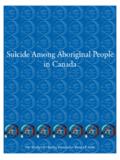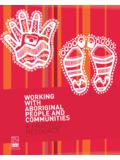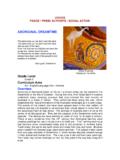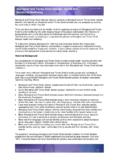Transcription of Aboriginal and Torres Strait Islander Education Action ...
1 Aboriginal and Torres Strait Islander Education Action Plan2010 2014 Front cover painting: This painting represents pathways to greater learning. The spiral is what life contributes, sometimes low, sometimes high. The result of persistence is the bloom, growth through learning. As a drop of water hits the surfaces the ripple effect is created, this is what is needed. Artist: Bronwyn Bancroft I have always supported the Education system at primary, secondary and tertiary levels, and firmly believe that Education for Indigenous people is imperative to our development and confidence. It allows us to participate with equity in an often inequitable society.
2 Ministerial Council for Education , Early Childhood Development and Youth Affairs ACN 007 342 421 PO Box 202 Carlton South Victoria 3053 Tel: (03) 9639 0588 Fax: (03) 9639 1790 Email: Website: Ministerial Council for Education , Early Childhood Development and Youth Affairs, and Education Services AustraliaAboriginal and Torres Strait Islander Education Action Plan 2010 2014 | 1 Contents1. Introduction .. National Collaboration .. ,. Jurisdictional Priorities .. Tracking Progress and Building on What Works .. 1: Glossary of Terms and Definitions ..43 Appendix 2: Selected References ..452 | Aboriginal and Torres Strait Islander Education Action Plan 2010 2014 Aboriginal and Torres Strait Islander Education Action Plan 2010 2014 | 3 1.
3 Introduction PrefaceGovernments across Australia recognise Aboriginal and Torres Strait Islander people as the First Australians with one of the oldest continuing cultures in human history. They affirm the right of Aboriginal and Torres Strait Islander people to sustain their languages and cultures and acknowledge associations with the land and water. Governments have agreed to take urgent Action to close the gap between the life outcomes of Aboriginal and Torres Strait Islander people and other Australians. To drive Action , the Prime Minister, Premiers and Chief Ministers have agreed through the Council of Australian Governments (COAG) to six ambitious targets: close the life expectancy gap within a generation; halve the gap in mortality rates for Aboriginal and Torres Strait Islander children under five within a decade; ensure all Aboriginal and Torres Strait Islander four year olds in remote communities have access to early childhood Education within five years (by 2013); halve the gap for Aboriginal and Torres Strait Islander students in reading, writing and numeracy within a decade (by 2018).
4 At least halve the gap in Aboriginal and Torres Strait Islander Year 12 attainment or equivalent attainment rates by 2020; and halve the gap in employment outcomes between Aboriginal and Torres Strait Islander Australians and other Australians within a decade (by 2018).Achieving these targets will require significant effort and collaboration by governments, their agencies, communities and the non-government, corporate and philanthropic sectors. Targets have been built into funding agreements between the Australian Government and State and Territory Governments and non-government Education providers as part of national of the Ministerial Council for Education , Early Childhood Development and Youth Affairs (MCEECDYA) have portfolio responsibilities associated with early childhood development and schooling and for services to assist students to make successful transitions to training, further studies or employment.
5 MCEECDYA wants all Australian children to have a high-quality, world-standard Education to equip them for life in the 21st century. 4 | Aboriginal and Torres Strait Islander Education Action Plan 2010 2014 Purpose The purpose of the Aboriginal and Torres Strait Islander Education Action Plan (the Plan) is to assist Education providers to accelerate improvements in the educational outcomes of Aboriginal and Torres Strait Islander children and young Plan seeks to progress the goals of the National Aboriginal and Torres Strait Islander Education Policy and the Melbourne Declaration on the Educational Goals of Young Australians and is part of a broader COAG reform agenda for school Education that will contribute to closing the gap between the educational outcomes of Aboriginal and Torres Strait Islander students and their peers.
6 It outlines how MCEECDYA Ministers will work together to achieve the closing the gap targets. Non-government Education providers have agreed to join with governments to achieve these targets and progress actions outlined in the Plan. It is acknowledged that this sector includes providers that operate autonomously as they are not part of a system authority and will therefore require a more flexible Plan reflects commitments by governments through COAG to introduce substantial structural and innovative reforms in early childhood Education and schooling as outlined in national agreements between the Australian Government and State and Territory Governments.
7 These reforms are designed to improve outcomes for all Australian students by increasing access to quality early childhood Education , improving literacy and numeracy achievement, addressing disadvantage in low socio-economic status school communities, improving teacher quality and increasing the number of young people attaining a Year 12 or equivalent qualification. Reform directions are detailed in the National Indigenous Reform Agreement, the National Education Agreement, the Early Childhood Education National Partnership, the Indigenous Early Childhood Development National Partnership, Remote Service Delivery National Partnership, the Smarter Schools - Improving Teacher Quality National Partnership, the Smarter Schools - Low Socio-economic Status School Communities National Partnership and the Smarter Schools - Literacy and Numeracy National Partnership, the Youth Attainment and Transitions National Partnership and other agreements.
8 Commitments made in these national partnerships and agreements are brought together in the Plan with a number of new and continuing complementary measures to close the gap between the educational outcomes of Aboriginal and Torres Strait Islander students and other Plan builds upon Australian Directions in Indigenous Education 2005-2008 (MCEETYA, 2006), which focused national effort in improving Aboriginal and Torres Strait Islander educational outcomes. It is informed by a review of Australian Directions commissioned by MCEECDYA and undertaken by prominent Aboriginal academics from across Australia (University of SA, 2009).
9 Aboriginal and Torres Strait Islander Education Action Plan 2010 2014 | 5 Overview The Plan identifies national, systemic and local level Action in six priority domains that evidence shows will contribute to improved outcomes in Aboriginal and Torres Strait Islander Education . These priorities and actions will guide effort over the next five years. The following diagram provides a conceptual overview of the overview of Aboriginal and Torres Strait Islander Education Action Plan 2010 2014 Pathways to Real Post- School options AttendanceReadinessfor SchoolLiteracy andNumeracyLeadership, QualityTeaching and WorkforceDevelopmentEngagement andConnectionsPRIDE CULTURE IDENTITYSAFETYA ustralian GovernmentNon-governmentState/TerritoryS chool/preschoolNATIONALSYSTEMICLOCALC hildren/Young PeopleReady for SchoolAttendingEngagedLearningAchievingF amilies/CommunityMinisterial Councils6 | Aboriginal and Torres Strait Islander Education Action Plan 2010 2014 Experience has shown that improvements in the educational outcomes of Aboriginal and Torres Strait Islander students arise from collaborative Action that is responsive to local needs.
10 As a consequence, Ministers have agreed in this Plan to identify a key group of schools called focus schools , some of which have been identified as sites for specific Action under national partnership agreements. By monitoring and taking Action in focus schools, Ministers will be assured that the benefits of national reforms are reaching Aboriginal and Torres Strait Islander students and that resources are used effectively to support the closing the gap targets. Focus schools will begin implementing actions outlined in the Plan during 2011, with all actions established as part of school planning processes by the end of the 2011 academic year.







